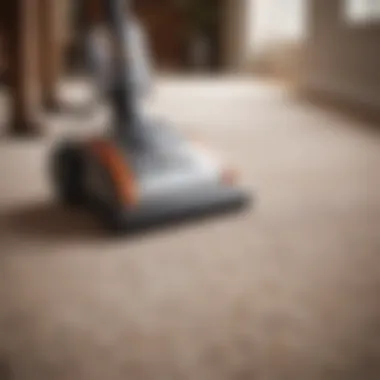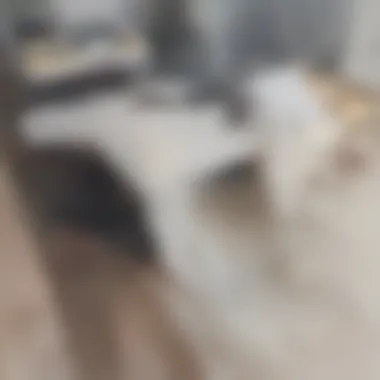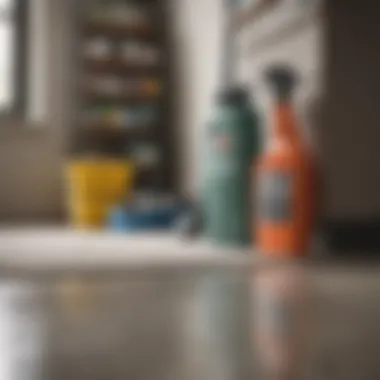Expert Guide to Cleaning Area Rugs with a Carpet Cleaner


Intro
Cleaning an area rug is a task that many homeowners underestimate. Area rugs can accumulate dirt, dust, and allergens, which affect both appearance and indoor air quality. The process requires a systematic approach, particularly when using a carpet cleaner. Understanding the right techniques and materials can greatly enhance the effectiveness of your cleaning.
Featured Homes
The Importance of Rug Care in Interior Design
Rugs are not merely decorative elements; they contribute significantly to the overall ambiance of a room. In high-end homes, the selection of rugs reflects personal taste and complements architectural design. Thus, keeping these items clean is essential not only for hygiene but also for aesthetic integrity.
"Caring for your rug enhances its beauty and longevity. It is an investment in your home's design."
Preparing Your Space
Before engaging in the cleaning process, ensure that the area is free of furniture and obstacles. This step not only makes the cleaning easier but also helps in preventing potential staining from items that might get wet. Additionally, remove any smaller items from the rug, such as decorative pillows or plants.
Cleaning Techniques
Assessing the Rug Type
Different rugs require different care methods. For instance, synthetic materials like nylon tend to be more durable than natural fibers such as wool. Identifying the material will guide the selection of cleaning agents and tools.
Gather Your Supplies
Before you begin, have the following tools and materials ready:
- Carpet cleaner (ensure it is suitable for your rug type)
- Vacuum cleaner
- Soft-bristle brush
- Clean towels or rags
- Warm water
- Mild detergent or rug-safe cleaning solution
The Cleaning Process
- Vacuum the Rug: Start by vacuuming both sides of the rug to remove loose dirt and hair.
- Pre-Treat Stains: If there are specific stains, apply a small amount of a suitable cleaning agent directly to the area, letting it sit briefly.
- Prepare Your Carpet Cleaner: Follow the manufacturer’s instructions to fill the machine with warm water and the recommended cleaning solution.
- Clean the Rug: Using the carpet cleaner, carefully work in sections. Avoid over-saturating the rug, as this can lead to mold growth.
- Rinse and Dry: After cleaning, rinse the rug with clean water if required, then use towels to blot excess moisture. It is crucial to ensure that the rug is completely dry to prevent odors or mildew.
Post-Cleaning Care
Upon completing the cleaning, consider the following:
- Regular Maintenance: Vacuum weekly to keep dirt at bay.
- Rotate the Rug: This helps with even wear and color fading due to sunlight.
- Professional Cleaning: For deep cleans, it may be beneficial to hire professional services once a year.
Understanding Area Rugs
Area rugs are not just decorative pieces; they play a vital role in defining the aesthetic of a room. Their placement can significantly influence the ambiance and comfort of a space. Understanding area rugs is essential for anyone looking to keep them in top condition. This section will explore various aspects that contribute to the appreciation and care of area rugs, which is particularly pertinent when considering cleaning methods like using a carpet cleaner.
Types of Area Rugs
Area rugs come in various styles, each designed for specific purposes and aesthetics. These include:


- Traditional Rugs: Often made with intricate patterns and designs, these rugs can elevate the décor of any room.
- Contemporary Rugs: Featuring modern designs and bold colors, contemporary rugs add a fresh look to spaces.
- Outdoor Rugs: These are crafted from durable materials suitable for outdoor settings, resistant to weather conditions.
- Shag Rugs: Known for their thick and plush texture, shag rugs provide a cozy feeling but require more maintenance.
Each type of rug has unique qualities and will respond differently to cleaning methods. It’s important to identify the type of area rug you have before embarking on cleaning, especially with a carpet cleaner.
Common Materials Used
Area rugs are crafted from a variety of materials, which impacts their cleaning requirements. Common materials include:
- Wool: Known for durability and resilience, wool rugs can often withstand stains well.
- Synthetic Fibers: Materials like nylon or polyester are affordable and easy to clean, making them popular choices for households.
- Silk: Luxurious but delicate, silk rugs require special care during cleaning to avoid damage.
- Cotton: These rugs are often machine washable but can wear down faster than others.
Recognizing the material composition of your area rug is crucial, as certain fibers can react adversely to harsh cleaning solutions or methods.
Importance of Regular Cleaning
Regular cleaning of area rugs is not merely about maintaining appearances; it is essential for prolonging their life. Here are key points to consider:
- Dust and Allergens: Rugs can trap dust, dirt, and allergens. Routine cleaning helps create a healthier living environment.
- Aesthetic Appeal: A clean rug enhances the overall beauty of a room. Stains and dirt can detract from its visual impact.
- Longevity: Regular maintenance can prevent fiber wear and prolong the life of the rug, ensuring longevity.
"Proper care and maintenance can help protect your investment in area rugs and maintain their charm for years to come."
When you understand the characteristics of your rug, it sets the foundation for effective cleaning techniques. This knowledge will guide you in selecting the right products and methods, ultimately promoting the rug’s preservation.
Pre-Cleaning Preparations
Pre-cleaning preparations are a vital phase in the process of cleaning an area rug using a carpet cleaner. This stage sets the foundation for effective cleaning and ensures that the subsequent steps will yield optimal results. Neglecting this preparatory phase can lead to inadequate cleaning, damage to the rug, or further complications down the line.
Assessing the Rug's Condition
Firstly, assessing the rug's condition is essential. Take a moment to examine your rug for any signs of wear or damage. Look for frayed edges, loose threads, and any discoloration. This gives useful information about how to proceed with cleaning. If the rug is very fragile or damaged, a simple carpet cleaner may not be suitable. In this case, professional assistance could be necessary to avoid worsening the condition. Consider the type and age of the rug as well. Older rugs or those made from delicate materials may require special care to retain their quality and appearance.
Gathering Necessary Tools
Next, gathering necessary tools is key to a successful cleaning task. You will need a few essential items which may include:
- A carpet cleaner that is suitable for your rug type
- Stain remover for tough stains
- Soft-bristle brushes or cloths for manual scrubbing
- A vacuum cleaner for debris removal
- Towels for drying and absorbing excess moisture.
Having these tools ready before you start will minimize delays and streamline your cleaning process. This will ensure you can start and complete the cleaning without interruptions.
Choosing the Right Carpet Cleaner
Finally, choosing the right carpet cleaner is significant for achieving optimal cleaning results. Not all cleaners are created equal; some may contain harsh chemicals that can damage certain materials. Investigate options that are gentle yet effective. Look for carpet cleaners that are specifically designed for area rugs. It’s advisable to read product reviews and possibly consult with retail staff or professionals in the industry. Brands such as Bissell and Hoover often feature products that are well-suited for home users.
By properly preparing through assessing your rug’s condition, gathering tools, and selecting the right carpet cleaner, you lay the groundwork for an effective cleaning. This preparation phase not only enhances the quality of the cleaning but increasingly extends the life and beauty of your area rug.
Technique for Cleaning
Cleaning an area rug with a carpet cleaner is not just a routine chore; it is an essential practice that can significantly prolong the life and maintain the beauty of your rug. The technique you employ directly impacts the effectiveness of the cleaning process. It involves understanding the carpet cleaner's mechanics, the specific techniques for application, and the follow-up care for your rug. By approaching this task methodically, you can achieve satisfactory results while also preserving the integrity of your area rug.


Setting Up the Carpet Cleaner
Begin by properly setting up your carpet cleaner. Always refer to the manufacturer's instructions. This step is crucial as each cleaner can differ slightly in operation.
- Fill the Tank: Use hot water mixed with the recommended carpet cleaning solution. Fill the tank according to the instructions provided to avoid dilution errors.
- Check Hose and Attachments: Ensure the hoses and attachments are clean and securely connected. A loose connection might lead to loss of suction and performance.
- Plug In and Test: Position the cleaner near an outlet and plug it in. Make sure the power cord is not in a pathway where it can be a tripping hazard. Test the cleaner briefly to ensure it's functioning properly.
Testing a Small Area
Before moving to clean the entire area rug, it is prudent to test a small, inconspicuous area. This step serves multiple purposes:
- Identify Colorfastness: Confirm that the dye in the rug is stable and will not bleed or fade.
- Check Cleaning Effectiveness: Observe how well the carpet cleaner interacts with the fiber without causing damage.
To perform this test, apply a small amount of solution to the corner of the rug and clean it. Wait until it dries before evaluating.
Cleaning Process Step-by-Step
The actual cleaning process of an area rug entails several steps:
- Begin with Vacuuming: Always vacuum the rug thoroughly before using a carpet cleaner. This removes loose dirt and debris, making the cleaning process more effective.
- Divide the Rug: Work in sections. This prevents the carpet cleaner from becoming overwhelming and ensures every part of the rug receives attention.
- Clean with the Carpet Cleaner: Using the cleaner, start from one corner and proceed slowly in straight lines. Overlap each stroke slightly to ensure even cleaning.
- Rinse if Necessary: Depending on the cleaning solution used, you may opt to go over the area with plain water to remove any remaining cleaning solution.
Dealing with Stains and Spots
In any cleaning endeavor, stains can be particularly troublesome. Here is a concise approach:
- Act Quickly: Address stains as soon as possible. The longer they sit, the harder they are to remove.
- Use the Right Cleaner: Certain stains may require specialized cleaners. For instance, pet stains may need enzyme-based solutions for complete removal.
- Blot, Don't Rub: When treating a stain, use a clean cloth to blot the area. Rubbing can cause the stain to set deeper into the fibers.
- Repeat as Needed: Don't hesitate to repeat the cleaning process on stubborn spots until they disappear. Just ensure to avoid over-saturation of the area.
Post-Cleaning Care
Post-cleaning care plays a significant role in maintaining the condition and aesthetics of an area rug. Proper attention to this phase ensures that your cleaning efforts do not go to waste. Not only does this help the rug regain its vitality, but it also prolongs its lifespan, preserving its structure and colors. By following effective post-cleaning practices, you can mitigate the risk of damage and enhance the overall appearance of your rug.
Drying the Rug
One of the essential steps in post-cleaning care is drying the rug correctly. Wet rugs can develop mold or mildew if not dried properly. After cleaning, it is necessary to ensure adequate airflow around the rug. It is often best to hang the rug outside on a dry, sunny day, as sunlight helps evaporate moisture. If hanging is not possible, placing it in a well-ventilated area indoors will suffice. Avoid using heat sources like hair dryers or radiators, as these can harm the fibers.
- Key Points for Drying:
- Ensure even airflow around the rug.
- Avoid direct heat sources.
- Sunlight can assist in the drying process.
Grooming the Fibers
Once the rug is dry, grooming the fibers is another important step. This involves using a carpet rake or a soft brush to gently fluff the fibers. Grooming helps restore the original texture of the rug and keeps the fibers standing upright. It can also help to eliminate any dirt particles that might have been left behind during the cleaning process. Regular grooming prevents matting and keeps the fibers looking fresh.
- Benefits of Grooming:
- Restores texture and appearance.
- Helps remove residual dirt.
- Prevents matting of fibers.
Storing the Rug Properly


If you need to store the rug, it is essential to do this correctly to avoid future damage. First, ensure that the rug is completely dry before rolling it up. Store it in a cool, dry place away from direct sunlight to prevent fading. Wrapping the rug in a breathable material, such as cotton, helps protect it from dust and pests.
- Storage Tips:
- Roll the rug, do not fold it.
- Use a breathable covering for protection.
- Keep it in a cool, dry environment.
Proper care after cleaning is vital for maintaining the longevity and beauty of your area rug. \n By implementing these post-cleaning practices, you help preserve the investment made in your area rugs, enhancing both their visual appeal and durability.
Maintenance Tips for Area Rugs
Maintaining an area rug requires diligence and knowledge. By following key maintenance tips, one can ensure that the rug not only looks good but also lasts longer. Care for the rug can minimize wear and tear, and it often preserves the value of the rug. Keeping up with the right maintenance is crucial for preserving its beauty and functionality.
Routine Cleaning Schedule
Establishing a regular cleaning schedule is vital for keeping area rugs in good condition. Depending on foot traffic, one should aim to vacuum the rug weekly. This simple task helps remove dirt and dust that can become embedded in the fibers over time.
In addition to vacuuming, deeper cleaning should occur every six months. During this time, a carpet cleaner can be utilized to refresh the rug. A deep clean eliminates built-up grime that ordinary vacuuming cannot reach. Always check the rug’s care instructions before using any cleaning solution. Properly planned cleaning intervals can mitigate the chances of permanent stains and discoloration.
Preventative Measures for Stains
Taking proactive measures can save rugs from unsightly stains. First, placing rugs in low-traffic areas decreases the likelihood of stains caused by spills or dirt. For high-traffic areas, consider using a rug pad to add a protective layer beneath the rug. This not only keeps the rug in place but also shields it from heavy wear.
In instances where spills do occur, it’s essential to act quickly. Blot the stain with a clean cloth rather than rubbing it, which can push the stain deeper. Keep a DIY stain removal solution handy, like a mixture of vinegar and water. This can prove effective for various stains. Educating family and guests about these preventative measures can also be beneficial.
Consulting Professionals When Necessary
There are times when the best course of action is to consult professionals. If the rug is valuable or a family heirloom, expert cleaning can prevent potential damage. Professionals can assess the rug's material and condition, providing a tailored cleaning approach.
Furthermore, some stains may require specialized treatment that regular cleaning methods cannot address. For example, pet stains or high-traffic areas may benefit from a professional's expertise. It’s always wise to research and select a reputable cleaning service, as this can make a significant difference in outcome.
"Regular maintenance and timely professional cleaning service can prolong the life of area rugs considerably."
Consequently, integrating these maintenance tips into the care of area rugs can pay off significantly in the long run. Whether through an organized cleaning schedule, taking precautions against spills, or knowing when to seek assistance, the effort involved can enhance the longevity and appearance of the rugs.
Culmination
Cleaning an area rug with a carpet cleaner is essential in maintaining both its appearance and durability. This article has outlined the necessary steps, techniques, and precautions involved in the cleaning process. By understanding the nuances of rug care, homeowners can avoid damaging their prized possessions while ensuring they remain vibrant and fresh.
Final Thoughts on Rug Care
In summary, proper rug care is not just about aesthetics; it extends to preservation and hygiene. Regular cleaning can prevent the buildup of dust, allergens, and bacteria, which can affect indoor air quality. Moreover, understanding the type of rug, including its material and construction, allows for tailored cleaning methods that enhance longevity. It is crucial to consider factors like sunlight exposure and foot traffic when assessing the need for regular cleaning.
Additionally, utilizing a carpet cleaner correctly can make a significant difference in the results. Ensuring that the chosen cleaner is compatible with the rug material and following the manufacturer’s instructions will yield a cleaner and more protected surface without adverse effects.
"A well-maintained rug can elevate the entire room's ambiance, reflecting the homeowner's dedication to their living space."
Encouraging Consistent Maintenance
Consistency is the key to effective rug maintenance. Establishing a routine cleaning schedule can greatly reduce the effort needed for deep cleaning. Simple tasks such as vacuuming and addressing spills immediately can keep the rug in good condition. A good practice is to vacuum the rug at least once a week, focusing on high-traffic areas.
Moreover, preventative measures can save time and resources in the long run. For example, using rugs pads can prevent slipping and protect the rug from wear caused by friction against the floor. When spills occur, blotting the area with a clean cloth—not rubbing—can help avoid further staining.
In some cases, professional cleaning may be required. Knowing when to consult professionals can effectively prolong the life of the rug. Professionals have access to advanced cleaning techniques and equipment that can handle tough stains safely.







